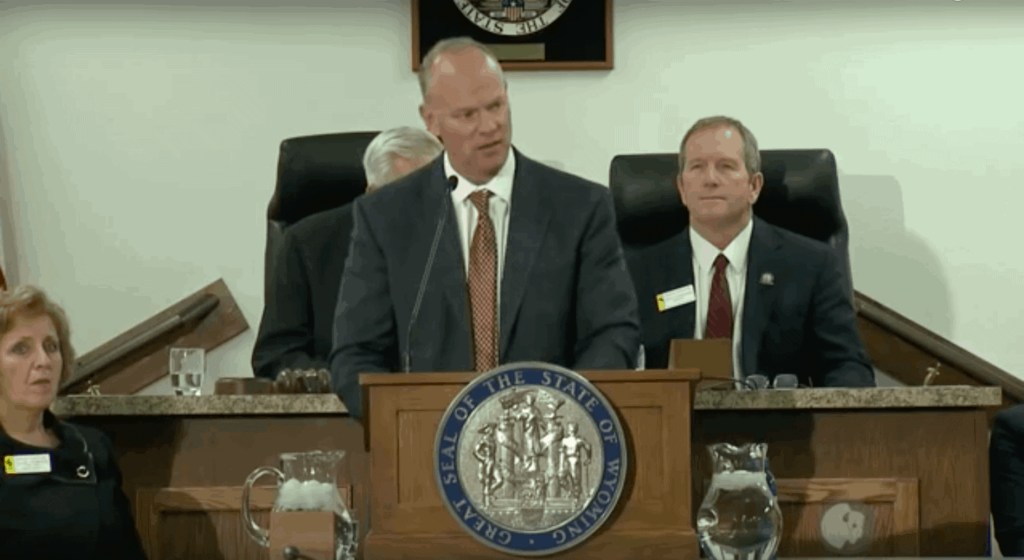[two_fifth last=”no” spacing=”yes” center_content=”no” hide_on_mobile=”no” background_color=”” background_image=”” background_repeat=”no-repeat” background_position=”left top” border_position=”all” border_size=”0px” border_color=”” border_style=”” padding=”” margin_top=”” margin_bottom=”” animation_type=”” animation_direction=”” animation_speed=”0.1″ class=”” id=””][fusion_text]January 11, 2017
Legislative observers will remember when “bang for your buck” was the top catch phrase in the Capitol. People just loved saying it.
Circa 2010, state lawmakers had poured money into funding education, so they wanted some results. The idea was: “Our kids’ scores in reading, math and science are some of the lowest in the country, and we’re spending more money on education per pupil than almost any other state. When is Wyoming going to start seeing some bang for its buck?”
Today, Wyoming’s got the bang, but we don’t have the bucks to sustain it.
[/fusion_text][/two_fifth][three_fifth last=”yes” spacing=”yes” center_content=”no” hide_on_mobile=”no” background_color=”” background_image=”” background_repeat=”no-repeat” background_position=”left top” border_position=”all” border_size=”0px” border_color=”” border_style=”” padding=”” margin_top=”” margin_bottom=”” animation_type=”” animation_direction=”” animation_speed=”0.1″ class=”” id=””][fusion_text]

[/fusion_text][/three_fifth][two_third last=”yes” spacing=”yes” center_content=”no” hide_on_mobile=”no” background_color=”” background_image=”” background_repeat=”no-repeat” background_position=”left top” border_position=”all” border_size=”0px” border_color=”” border_style=”” padding=”” margin_top=”” margin_bottom=”” animation_type=”” animation_direction=”” animation_speed=”0.1″ class=”” id=””][fusion_text]Wyoming’s K-12 public schools rank seventh in the nation, according to a study by Quality Counts published last week that reviews each state’s education spending, test scores, and other measures. The six states above us are all on the East Coast.
“We don’t even know where the East Coast is in Wyoming,” Gov. Matt Mead joked this morning during his annual “State of the State” address.
Mead discussed education at length before a joint session of the Legislature, using the state’s achievements as a positive preamble before moving on to the grim tale of the $1.5 billion shortfall state education faces over the next six years. He implored the lawmakers to take action. But he didn’t tell them anything they didn’t already know, and he didn’t provide any solutions.
He shouldn’t feel too bad, though. Nobody else has either.
Mead’s record of getting the Legislature to take his advice is spotty—its blunt rejection of his call to expand Medicaid, for instance. Still, he chastised lawmakers for their inaction in the face of the budget crisis.
“As I did last year, again I ask that we form a task force with full participation from Wyoming stakeholders to address school funding,” Mead said. “Because a year has gone by, and things have not gotten better.”
Mead did acknowledge one attempt by legislators to make headway—a “white paper” that a subcommittee produced after taking just a week’s worth of public comment. He held it up as the wrong way to start toward a real, long-term fix.
“I ask now as I’ve asked before, that we work together to discuss solutions that include the public, teachers, school boards, and parents,” Mead said. “One week is not enough.”
Of course, as the energy bust continues into its third year, education is not the only public program in peril—the $1.5 billion figure does not even include school capital construction or maintenance costs. Those came out of coal lease bonus funds that have dried up as the coal market has diminished. Schools being built now are likely to be the last ones residents will see going up for a while, except in a few fortunate districts that have had projects already approved and are in the budget pipeline.
Mead spelled out in simple terms a request to draw from the state’s $1.6 billion “rainy day fund,” which would grow if left untouched.
“The ‘rainy day fund’ is made for rainy days, like we’ve been having the past couple years,” he said. “It’s raining.”
Mead asked lawmakers to divert $21 million from the account for the Title 25 program to fund involuntary hospitalizations, $19.2 million to renovate or rebuild the State Penitentiary in Rawlins, and $142 million for the Budget Reserve Account. Meanwhile, renovations to the Capitol building continue to the tune of $300 million.
Mead cut his biennial budget for the executive branch last year by 11 percent. He asked everyone in Wyoming to prepare to see even more cuts because energy prices remain low. Mineral severance taxes from the fossil fuels industry pays about 70 percent of the cost of operating state government.
But energy is not the only factor. As recently as 2015, investments through the state Treasurer’s Office, which oversees a large network of stock investors, were being hailed as the savior of state government. Income from investments topped $1 billion for the first time, becoming the state’s second highest source of revenue.
At the time, Treasurer Mark Gordon warned lawmakers not to expect those high returns to continue in the wake of low minerals prices. And he was right.
“We’re getting poor investment returns,” Mead said. “It’s a challenging investment market, but things are not going well, even compared to other states.”
During high times for investment, it was easy to overlook the $75 million per biennium it cost to manage Wyoming’s stock portfolio. Now that the money has stopped flowing in, Mead suggested payments to stockbrokers might be a place to look for cuts.[/fusion_text][/two_third]

